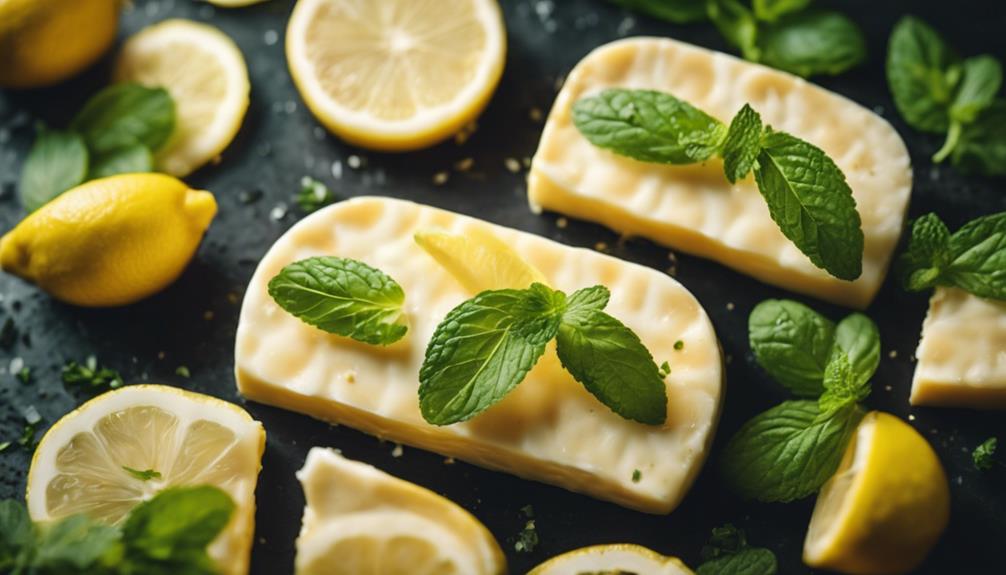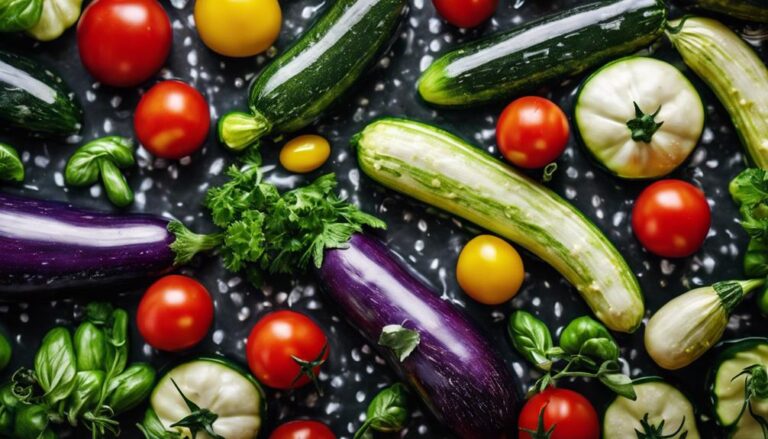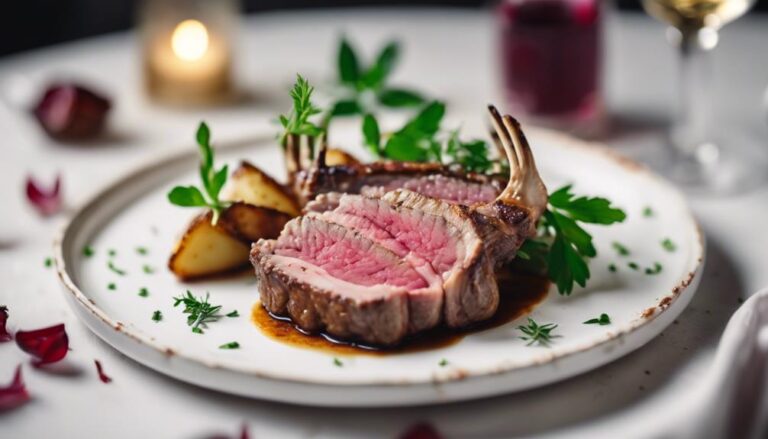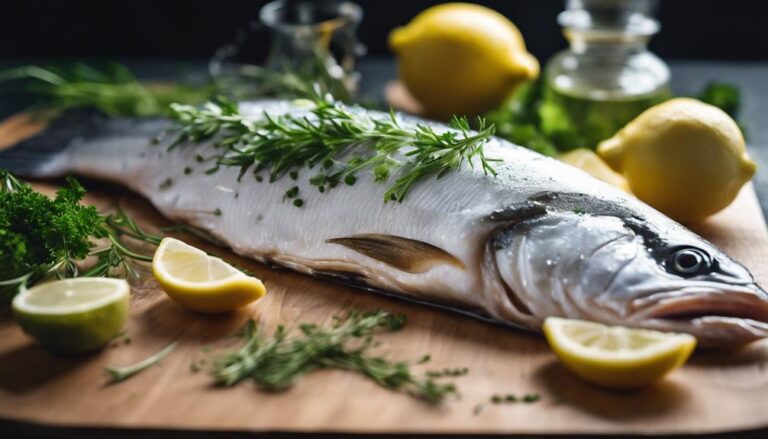Sous Vide Halloumi Cheese With Lemon and Mint
Immerse halloumi cheese with lemon and mint in a sous vide bag. Seal to eliminate air. Set sous vide to 135°F for 1 hour. This guarantees a perfect texture. The lemon adds citrusy brightness, while mint brings invigorating freshness. After sous vide, pan-sear for a golden crust. The flavors meld beautifully. Explore the depths of culinary delight with this harmonious dish.
What You Will Learn Here
- Sous vide method ensures precise temperature control for perfect halloumi texture
- Lemon infusion enhances halloumi's citrus notes
- Mint adds refreshing and aromatic element to the dish
- Sous vide retains halloumi's unique squeaky texture
- Perfect balance of flavors with lemon, mint, and halloumi
Halloumi's Mediterranean Culinary Roots

Halloumi cheese, originating from Cyprus, is deeply rooted in Mediterranean culinary traditions. Its unique texture and ability to retain shape when cooked have made it a versatile ingredient in various dishes.
The blend of goat and sheep milk gives halloumi a distinct flavor profile that complements both classic and modern recipes.
Halloumi Cheese Origins
Originating in the sun-kissed Mediterranean region, particularly Cyprus, the semi-hard cheese known for its unique cooking properties and rich flavor has captivated chefs and food enthusiasts worldwide. Halloumi cheese, traditionally made from a blend of goat and sheep milk, has gained popularity for its ability to maintain its shape when cooked, making it perfect for grilling, frying, or barbecuing. This versatile cheese is often used as a meat substitute in various dishes like burgers and kebabs. Its origins in Cyprus contribute to its authentic Mediterranean taste and culinary significance. The unique characteristics of halloumi have made it a beloved ingredient in both traditional Mediterranean cuisine and modern gastronomy.
| Halloumi Cheese Origins | ||
|---|---|---|
| Region | Mediterranean | Cyprus |
| Main Ingredients | Goat and Sheep Milk | |
| Cooking Properties | Retains shape when cooked | Ideal for grilling, frying, barbecuing |
| Popular Uses | Meat substitute in dishes like burgers, kebabs | |
| Global Popularity | Captivating chefs and food enthusiasts worldwide |
Mediterranean Flavor Profile
With its roots deeply intertwined in Mediterranean culinary traditions, the distinctive flavor profile of halloumi cheese showcases a harmonious blend of salty richness and versatile textures. This semi-hard cheese, a staple in Cyprus, is traditionally crafted from a combination of goat and sheep milk, imparting a unique taste that's both savory and slightly tangy.
Halloumi's ability to hold its shape when grilled, fried, or barbecued, without melting but simply softening, makes it a versatile ingredient in various Mediterranean dishes. Its salty undertones complement dishes perfectly, especially when paired with invigorating flavors like lemon and mint. The combination of these elements creates a dish that isn't only flavorful but also embodies the essence of Mediterranean cuisine.
Culinary Traditions Influence
Incorporating centuries-old culinary methods and regional influences, halloumi cheese embodies the essence of Mediterranean gastronomy. Originating from Cyprus, this cheese is traditionally crafted from a blend of goat and sheep milk, lending it a distinctive flavor profile.
Its unique characteristic of retaining its shape when cooked, yet softening beautifully, has made it a beloved choice for grilling and frying in Mediterranean cuisine. The Mediterranean culinary roots of halloumi extend to the incorporation of flavors like lemon zest, adding a revitalizing and tangy twist to dishes.
The versatility of halloumi in various cooking methods, such as grilling, frying, or barbecuing, showcases how this cheese has seamlessly integrated into the rich tapestry of Mediterranean flavors and culinary traditions.
Halloumi Cheese Brine Varieties

To create diverse flavor profiles for halloumi cheese, experiment with a variety of brine options including ingredients like lemon juice, vinegar, herbs, and spices. Brining halloumi cheese can greatly impact its taste and texture, adding layers of complexity to your dishes. Here are some brine variations you can try:
- Lemon and Herb Brine: Infuse your halloumi with a revitalizing citrusy zing by combining water, salt, lemon juice, and fresh herbs like thyme or oregano in the brine mixture.
- Spicy Chili Brine: For those who enjoy a bit of heat, consider preparing a brine with water, salt, chili peppers, and other spices like cumin or paprika to give your halloumi a punch of spiciness.
- Garlic and Peppercorn Brine: Enhance the flavor profile of your halloumi with a brine mixture containing water, salt, crushed garlic cloves, and whole peppercorns, creating a savory and aromatic cheese that pairs well with various dishes.
Experimenting with different brine options allows you to customize the taste of your halloumi cheese to match your preferences and culinary creations.
Summery Halloumi Recipe Selection
When choosing a summery halloumi recipe, think about the vibrant options like Grilled Halloumi With Lemon, Halloumi and Watermelon Salad, and Mint-infused Halloumi Skewers. These recipes offer a rejuvenating twist to traditional halloumi dishes, perfect for a light and flavorful summer meal.
The combination of ingredients like lemon, mint, and watermelon adds an invigorating and rejuvenating flavor profile to the halloumi cheese.
Grilled Halloumi With Lemon
Grill up some halloumi with an invigorating squeeze of lemon for a revitalizing and satisfying summer dish. The combination of the smoky halloumi and the zesty lemon juice creates a burst of flavors that will tantalize your taste buds. Here's why this dish stands out:
- Enhanced Flavor: The grilling process intensifies the halloumi's flavors, while the lemon juice cuts through the richness, adding a rejuvenating twist.
- Textural Contrast: Grilling halloumi results in a crispy exterior that contrasts beautifully with its soft, gooey interior, offering a delightful mouthfeel.
- Perfect for Summer: This dish is ideal for outdoor gatherings or BBQs, providing a light, yet satisfying option that captures the essence of summer.
Halloumi and Watermelon Salad
Enjoy the harmonious blend of flavors and textures with this Halloumi and Watermelon Salad, an invigorating and vibrant dish perfect for summer dining. This salad offers a delightful mix of sweet watermelon, salty halloumi, and zesty lemon, creating a revitalizing taste experience. Here's why this Halloumi and Watermelon Salad is a must-try:
- Contrasting Textures: The crispy grilled halloumi complements the juicy watermelon, adding a satisfying crunch to every bite.
- Bright Lemon Zest: The addition of lemon zest enhances the flavors, providing a citrusy brightness that cuts through the richness of the halloumi.
- Invigorating Mint: Fresh mint leaves bring a cooling element to the salad, elevating its overall freshness and providing a burst of herbal flavor.
Mint-infused Halloumi Skewers
Infuse your summertime grilling sessions with vibrant flavors by preparing these mint-marinated Halloumi skewers, an invigorating vegetarian option that promises a burst of zesty satisfaction. Here's why you should consider making this dish:
- Invigorating Flavor: The combination of fresh mint, zesty lemon, and grilled halloumi creates an invigorating taste profile that's perfect for warm weather gatherings.
- Vegetarian Delight: As a vegetarian option, these skewers offer a flavorful and satisfying alternative for those seeking meatless grilling options.
- Colorful Presentation: Alternating pieces of marinated halloumi, cherry tomatoes, and bell peppers on skewers not only enhance the dish's visual appeal but also add a variety of textures and flavors to each bite.
Grilling Halloumi Cheese Perfectly
To grill halloumi perfectly, make sure your grill is set to medium-high heat and cook each side for 2-3 minutes until golden brown grill marks appear.
Enhance the cheese's flavor by pairing it with fresh herbs like mint, a squeeze of lemon juice, or a drizzle of olive oil.
Properly oiling the grill grates or brushing the halloumi with oil before grilling will prevent sticking and ensure even cooking.
Grilling Temperature and Time
When grilling halloumi cheese perfectly, maintain a medium-high temperature of around 400-450°F for best results. This temperature range allows the halloumi to develop a golden brown crust while retaining its signature squeaky texture.
Grill the halloumi for about 2-3 minutes per side, ensuring even cooking and a crispy exterior. The high melting point of halloumi is key here, as it prevents the cheese from melting away and helps create that desirable charred finish.
Flavor Pairings for Halloumi
Maintain a crisp exterior and a tender inside by pairing your grilled halloumi cheese with complementary flavors. When looking to replace the chicken, consider these flavor pairings to elevate your grilled halloumi experience:
| Flavor Pairing | Description |
|---|---|
| Honey | Adds a touch of sweetness to balance the saltiness. |
| Watermelon | Provides a invigorating and revitalizing contrast. |
| Pomegranate Seeds | Adds a burst of tanginess and visual appeal. |
| Chili Flakes | Offers a hint of heat to complement the savory cheese. |
| Fresh Basil | Brings a fragrant and herbaceous note to the dish. |
Experiment with these combinations to discover your favorite way to enjoy perfectly grilled halloumi cheese.
Texture and Flipping Techniques
For achieving the perfect texture and achieving ideal results when grilling halloumi cheese, consider implementing effective flipping techniques.
When grilling halloumi, it's crucial to substitute the chicken with the cheese and make sure that each side cooks evenly. Start by preheating your grill to medium-high heat and oiling the grates to prevent sticking.
Place the halloumi directly on the grill and let it cook for about 2-3 minutes on each side. Use a spatula to carefully flip the cheese, ensuring a golden brown crust forms.
Final Thoughts
Considering the unique texture and flavors achieved through sous vide cooking, exploring different herbs and seasonings to complement the halloumi cheese could elevate the dish even further. When considering replacements for chicken in sous vide cooking, halloumi cheese stands out as a versatile and delicious option.
The ability of halloumi cheese to absorb flavors makes it an ideal candidate for experimenting with various herbs and seasonings. To enhance the dish, you could try incorporating thyme for earthy notes, rosemary for a pine-like aroma, or even chili flakes for a hint of spice. Pairing halloumi cheese with lemon and mint already provides an invigorating and zesty flavor profile, but don't hesitate to venture into other flavor combinations to discover new and exciting tastes.
Considering the precise temperature control and moisture retention of sous vide cooking, you can be confident that the halloumi cheese will maintain its integrity while infusing all the chosen flavors. So, next time you sous vide halloumi cheese, don't shy away from experimenting with different herbs and seasonings to create a truly unique and delightful dish.
Frequently Asked Questions
Does Halloumi Have Mint?
You don't typically find mint in halloumi cheese itself, but when combined, the minty halloumi duo offers a delightful blend. Mint adds a invigorating kick to the salty cheese, creating a harmonious balance of flavors that elevate your dish.
How Do You Keep Halloumi From Getting Rubbery?
To prevent halloumi from getting rubbery, you should consider using the sous vide method. This technique helps maintain the cheese's texture by cooking it at a precise temperature for a perfect consistency. Vacuum-sealing with flavors enhances taste.
Should You Soak Halloumi Before Cooking?
You shouldn't soak halloumi before cooking if you want to preserve its unique texture. Soaking can make it too soft and alter its firmness. Cooking halloumi without soaking helps it stay crispy outside while remaining soft inside, maintaining its distinct qualities.
What Temperature Should Halloumi Be Cooked At?
When cooking halloumi, precise temperature control is crucial. Set your sous vide to 167°F (75°C) for 45 minutes. This method guarantees the cheese softens without losing firmness, allowing flavors like lemon and mint to infuse evenly.
Conclusion
To sum up, sous vide halloumi cheese with lemon and mint offers a flavorful and unique twist on this traditional Mediterranean cheese.
By utilizing different brine varieties and grilling techniques, you can elevate the dish to new heights.
The combination of tangy lemon and invigorating mint adds a revitalizing touch to the rich and savory halloumi.
Experiment with different flavors and methods to create your own delicious halloumi creations. Enjoy the culinary journey!











